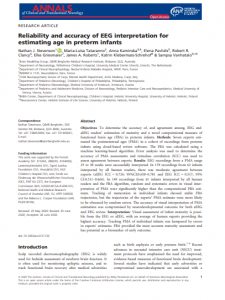
Objectives
To determine the accuracy of, and agreement among, EEG and aEEG readers’ estimation of maturity and a novel computational measure of functional brain age (FBA) in preterm infants.
Methods
Seven experts estimated the postmenstrual ages (PMA) in a cohort of recordings from preterm infants using cloud‐based review software. The FBA was calculated using a machine learning‐based algorithm. Error analysis was used to determine the accuracy of PMA assessments and intraclass correlation (ICC) was used to assess agreement between experts.
Results
EEG recordings from a PMA range 25 to 38 weeks were successfully interpreted. In 179 recordings from 62 infants interpreted by all human readers, there was moderate agreement between experts (aEEG ICC = 0.724; 95%CI:0.658–0.781 and EEG ICC = 0.517; 95%CI:0.311–0.664). In 149 recordings from 61 infants interpreted by all human readers and the FBA algorithm, random and systematic errors in visual interpretation of PMA were significantly higher than the computational FBA estimate. Tracking of maturation in individual infants showed stable FBA trajectories, but the trajectories of the experts’ PMA estimate were more likely to be obscured by random errors. The accuracy of visual interpretation of PMA estimation was compromised by neurodevelopmental outcome for both aEEG and EEG review.